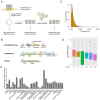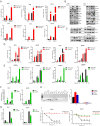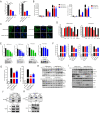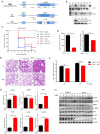A genome-wide CRISPR screening uncovers that TOB1 acts as a key host factor for FMDV infection via both IFN and EGFR mediated pathways
- PMID: 38512977
- PMCID: PMC10986976
- DOI: 10.1371/journal.ppat.1012104
A genome-wide CRISPR screening uncovers that TOB1 acts as a key host factor for FMDV infection via both IFN and EGFR mediated pathways
Abstract
The interaction between foot-and-mouth disease virus (FMDV) and the host is extremely important for virus infection, but there are few researches on it, which is not conducive to vaccine development and FMD control. In this study, we designed a porcine genome-scale CRISPR/Cas9 knockout library containing 93,859 single guide RNAs targeting 16,886 protein-coding genes, 25 long ncRNAs, and 463 microRNAs. Using this library, several previously unreported genes required for FMDV infection are highly enriched post-FMDV selection in IBRS-2 cells. Follow-up studies confirmed the dependency of FMDV on these genes, and we identified a functional role for one of the FMDV-related host genes: TOB1 (Transducer of ERBB2.1). TOB1-knockout significantly inhibits FMDV infection by positively regulating the expression of RIG-I and MDA5. We further found that TOB1-knockout led to more accumulation of mRNA transcripts of transcription factor CEBPA, and thus its protein, which further enhanced transcription of RIG-I and MDA5 genes. In addition, TOB1-knockout was shown to inhibit FMDV adsorption and internalization mediated by EGFR/ERBB2 pathway. Finally, the FMDV lethal challenge on TOB1-knockout mice confirmed that the deletion of TOB1 inhibited FMDV infection in vivo. These results identify TOB1 as a key host factor involved in FMDV infection in pigs.
Copyright: © 2024 Peng et al. This is an open access article distributed under the terms of the Creative Commons Attribution License, which permits unrestricted use, distribution, and reproduction in any medium, provided the original author and source are credited.
Conflict of interest statement
The authors have declared that no competing interests exist.
Figures







Similar articles
-
Foot-and-Mouth Disease Virus Viroporin 2B Antagonizes RIG-I-Mediated Antiviral Effects by Inhibition of Its Protein Expression.J Virol. 2016 Nov 28;90(24):11106-11121. doi: 10.1128/JVI.01310-16. Print 2016 Dec 15. J Virol. 2016. PMID: 27707918 Free PMC article.
-
Constitutively Active IRF7/IRF3 Fusion Protein Completely Protects Swine against Foot-and-Mouth Disease.J Virol. 2016 Sep 12;90(19):8809-21. doi: 10.1128/JVI.00800-16. Print 2016 Oct 1. J Virol. 2016. PMID: 27466421 Free PMC article.
-
Foot-and-Mouth Disease Virus 3A Protein Causes Upregulation of Autophagy-Related Protein LRRC25 To Inhibit the G3BP1-Mediated RIG-Like Helicase-Signaling Pathway.J Virol. 2020 Mar 31;94(8):e02086-19. doi: 10.1128/JVI.02086-19. Print 2020 Mar 31. J Virol. 2020. PMID: 31996428 Free PMC article.
-
Silencing of the foot-and-mouth disease virus internal ribosomal entry site by targeting relatively conserved region among serotypes.Virus Genes. 2019 Dec;55(6):786-794. doi: 10.1007/s11262-019-01696-6. Epub 2019 Jul 31. Virus Genes. 2019. PMID: 31367998 Free PMC article.
-
Robust Protection against Highly Virulent Foot-and-Mouth Disease Virus in Swine by Combination Treatment with Recombinant Adenoviruses Expressing Porcine Alpha and Gamma Interferons and Multiple Small Interfering RNAs.J Virol. 2015 Aug;89(16):8267-79. doi: 10.1128/JVI.00766-15. Epub 2015 Jun 3. J Virol. 2015. PMID: 26041279 Free PMC article.
Cited by
-
The impact of 12C6 heavy ion irradiation-induced cellular mutations on the replication of the foot-and-mouth disease virus and the role of Cbr3.Cell Mol Life Sci. 2025 Jun 28;82(1):261. doi: 10.1007/s00018-025-05628-6. Cell Mol Life Sci. 2025. PMID: 40580333 Free PMC article.
-
Identification of host factors for livestock and poultry viruses: genome-wide screening technology based on the CRISPR system.Front Microbiol. 2024 Nov 21;15:1498641. doi: 10.3389/fmicb.2024.1498641. eCollection 2024. Front Microbiol. 2024. PMID: 39640855 Free PMC article. Review.
References
MeSH terms
Substances
LinkOut - more resources
Full Text Sources
Molecular Biology Databases
Research Materials
Miscellaneous

